main: September 2007 Archives

All My Works Are A Form Of Wishing
Yoko Ono
Blogger and journalist Mary Louise Schumacher at the Milwaukee Journal Sentinel wrote she was "cranky" this week about "Public Relations" stealing the artistic mission of public art. "Visit Milwaukee" will commission a bronze statue of "the Fonz" from the 1970s TV show "Happy Days". Apparently, Milwaukee is copying a TV Land project that donated bronze sculptures of TV character "Mary Richards" to Minneapolis and "Bob Hartley" to Chicago among others. These shows are already dying away. Left by themselves in the public realm, the sculptures will become memorials to the 20th Century middle-class attire without the story-telling detail of Duane Hanson's loners. I hope "Visit Milwaukee" is smart enough to design 1970's video monitors into the site to explain the sculpture. If not, the bronze can be melted and reused in 25 years.
Ms. Schumacher may not have seen the stupidity applied to the streets of Brussels by the AGC Flat Glass Europe company in collaboration with International Polar Foundation. As nothing is stated in the press release or website, I assume the some backroom graphic designer was told to design a hundred trees in the absolutely cheapest way possible. The laser cut shapes are painted nursery school toy colors and stuck in the ground like a stop sign. At an auction in one week, you can buy one of seven signed by the director of the foundation. I guess this guy has quite a cult of personality in Europe.
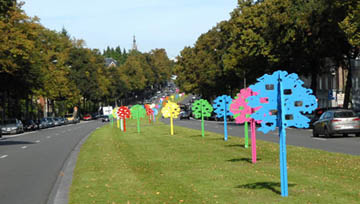
AGC Trees in Brussels, Sept-Oct, 2007

AGC Online "Dream Trees" for Architects (and others)
If this is not bad enough, the company then asked the architects (AGC customers that specify their glass) to type "hopes for a brighter world" or "your dream". Each dream is printed on a piece of AGC glass with the AGC logo and crudely hung in the crudely cut opening. All the online press info focuses on the CEO of the company and the director of the foundation. The pretty website lets anyone submit a dream, but for unknown purposes.
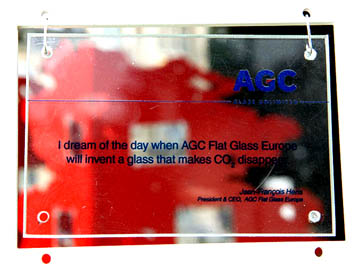
The CEO of AGC Dream. I hope for all the trees in the world that the translation to English is horrible.
"Visit Milwaukee" can still improve the situation and hire an artist to provide some cultural depth to the effort. If "Visit Milwaukee" is not interested in depth of expression and thinking, they should take a favorite picture of the Fonz and send it directly to a Chinese foundry. Learn from the boys in Brussels and cutout the middleman - better known as the artist.
People like me try to keep an open mind but still get annoyed when corporations and foundations with cash don't bother to seek the best when USING the format and reputation of art as a PR tool. PR is a fine goal, but please strive for the best creative work within the company's means and targeted audience. Don't degrade yourself and the community through artistic laziness. Coca-Cola did a fair job by hiring Peter Blake to promote the company's "Make a Coke Poster" website.
On a conceptual level (if I dare use such a word), the boys of Brussels were piggybacking Yoko Ono's decades long project called "Imagine Peace". I assume that the International Polar Foundation would be very much aware that Yoko Ono intended to take the hundreds of thousands of wishes tied to live trees and preserve them at the Imagine Peace Tower in ICELAND. The tower will be dedicated this October. (See tower image at top of blog incomparison to NYC light. Photo by Wassman)
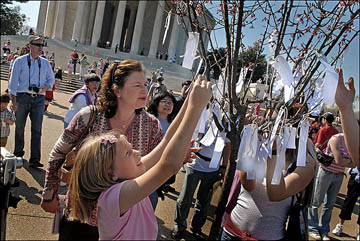
Yoko Ono "Imagine Peace" Wish Trees in Washington,DC, April, 2007 (Photo Wash. Post)
Yoko Ono has been using a very old idea from Asia of the tying wishes to trees. I have seen other artists and other community activists create the wish trees for local events based on the "open source" idea. This simple act of taking a moment to handwrite a personal wish has a religious feeling. Indian street shrines, Chinese house shrines and Catholic saint candles perform this same short, concentrated connection to something spiritual - and peaceful.
This is Ono's artistic intelligence. She is using the old wish tree as method to have tens of thousands of people participate in the feeling of peace by writing and tying the wish. The boys in Brussels have used the same wish trees but robbed its emotional response. Online and in the street, the dream is de-personalized and presented with the writer's name introducing the ego. Rather than anonymous scraps of paper, the "comment box" results in self-conscious public relations activity by all the writers. ( Of course, I wanted to be clever to try to seek an insult about the project into the project. )
Mail a Postcard or Email a Wish for Peace
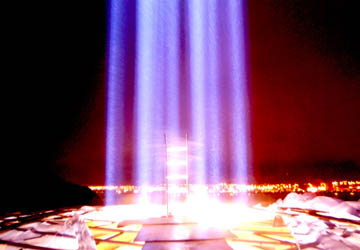
Ono's Imagine Peace Tower reuses ideas by others - most recently the "Towers of Light" to remember the feelings of loss after 9/11. (I did not know that the light is still projected every year on September 11. See Flickr.) I am not familiar with Ono's work, but she is not afraid of using existing artistic formats that best connects to her message. Using light with an on-off switch at a faraway corner of the planet, she reinforces the communal mental energy that implies that she believes in its powerful influence. As she will write on the physical element of the sculpture: A dream you dream alone is only a dream. A dream you dream together is reality.
It continue's her great 1969 work with John Lennon, "War is Over", not "THE War is Over". Strike war from us and substitute peace. I so wish it could come true.
John Lennon and Yoko Ono 1969 Billboard
Digg it...Del.icio.us ...Technorati...Stumble Upon..Reddit
Not to keep the nun theme alive, but yesterday the Boston newspapers reported that the new owner of the Boston Gas Tanks painted by Corita Kent in 1971 would be preserved. The original tank was demolished in 1992, but the owner at that time - KeySpan - repainted another tank.
Ms. Kent was an anti-war nun until 1967 when she left her Catholic order and her position as head of the art department at Immaculate Heart College. According to the following article: "In the 1960s, Sister Corita poured her considerable energy into another passion - the anti-war movement. She became an activist, using her art as a means of protest; her "Peace on Earth" 1965 Christmas Exhibit, at IBM's New York showroom, was deemed too "subversive" for display. She did tone it down, but later remarked, "I am not brave enough to not pay my income tax and risk going to jail. But I can say rather freely what I want to say with my art."
Due to her anti-war activities, many people saw Ho Chi Minh's profile in blue. Later with the repainting, the conspiracy theory universe claimed the "nose" was rounded to reduce the likeness to the revolutionary leader of Vietnam. Apparently Ms. Kent never made a statement about the likeness.
A big thank you to the new owner - "National Grid" - for recognizing the value of this piece of art and its history. Link to some of Kent's excellent graphic work
November 1967 Newsweek Cover and 1985 Stamp by Kent
Ho Chi Minh??? and the Repainting of the Nose???
From Google Sightseeing
Digg it...Del.icio.us ...Technorati...Stumble Upon..Reddit
In 1988, Philippine Duchesne was canonized by Pope John Paul II. She is one of only six American saints: five nuns and one bishop. An organizer of the Sisters of the Sacred Heart in France, she was granted her dream to serve as missionary in the USA in 1817. Traveling up the French Catholic Mississippi to St. Charles, Missouri, she founded the first Sacred Heart house in the USA.
At the end of her life in the 1840s, she worked with the Potawatomi people that had been forced marched from Indiana to Kansas in 1838 on the "Trail of Death". The Potawatomi Catholics still respect her memory at the St. Mary's Sugar Creek Mission.
When a notice of the winner of the Foundry Art Centre's "Historic Figures in Bronze - Art in Public Places" competition arrived in my mailbox, I knew nothing of Saint Phillippine, the Potawatomi people, the "Trail of Death", American saints or the Sisters of the Sacred Heart. Now I know. And that is good.
Map of "Trail of Death" and 2004 Potawatomi Catholics
To me, this knowledge is the goal of the interpretative film, novel, sculpture or plaque regarding the historical person or event (historic in that nobody is alive that was there.) The rumors surrounding the historic person must be alive in some group of people. Permanent artistic interpretation of the historic person reflects directly on the people that commissioned or displayed the work of art. From the point of view of the sponsors, artwork is made as a way to speak to the future about the sponsors. (The artists have different reasons.) The future can be the next day as well as the next century. Yes, even tomorrow is the future. If the value was only for moment, then permanent art would not be necessary. The action of spoken words would be sufficient.
There is another kind of recording that is not artistic. Generally, "objectivity" or "consensus opinion" is valued in the recorder's efforts. This purpose of the recording is for efficiency. Writing or photographing or sculpting can convey the ideas about the historic person and the recorder's attitude when the recorder is not present. Millions of people can learn through a ten-minute television broadcast or a through a hundred years of tourists passing the marker.
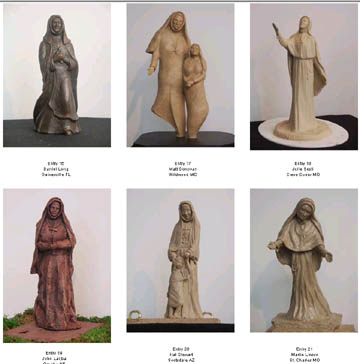
This confusion of the tasks of the recorder or the artist causes some of the problems with public art related to historic persons or events. The artist is frequently asked to be the recorder rather than the presenter of TODAY'S understandings. The artist is asked to make a "timeless" artwork which actually means a preconceived idea of the physical attributes of art serving the role of recorder, not art. As recorder, the artist is trapped inside the "consensus opinion" about the person or event. The larger the intended audience, the more generic the "consensus opinion".
The competition for a sculpture regarding Philippine Duchesne suffers from this situation. All the artworks are recording the generic consensus opinion - a nun that prayed and had some positive relationship with children, especially Native American. Almost all include the crucifix and rosary beads. The flowing and/or enclosing feature of a nun's habit is the primary formal aspect within a totem or triangular compositional format. Oversized heads, hands and crucifixes create emphasis. The body is repressed. The only unique element is a chicken and a staff.
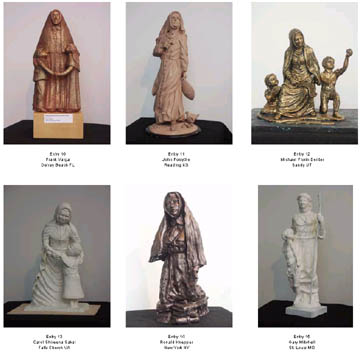
When viewing the competition entries, I have no idea why the sponsors think this woman is special or why she is a saint. Nothing really special about praying and loving children that is practiced by a majority of human beings. None of the sculptures demonstrate any internal emotional complexity that must have existed in a lone woman from France on the American frontier helping people considered "sub-human" by many. To me, her personal resolve must have been as powerful as Mother Teresa in India.
The winner, Harry Weber, is just a generic as the next. The artists in the competition and the sponsors have developed a set of criteria that I do not understand, but I am guessing has something to do with craftsmanship and compositional interest. From my point of view, all the works are without inspiration or risk in the making or the telling. But more important, I know nothing about the sponsors and their appreciation for this woman of faith and action.
Weber's winning entry and his 2006 winning sculpture of Daniel Boone
What has emerged in America is a series of artistic groups that do not interact with each other. We have always understood that the remaking of traditional crafts, such as quilting, have their own rules and can be appreciated on those grounds. Now we have more and more fine art groups that repeat like traditional crafts. A short list of groups might include bronze figures, bronze animals, abstract stainless steel, semi-abstract stone carvers and oil landscapes.
Even though I might be too ignorant to appreciate these works, artists and curators within the group are quite sophisticated and understand quality artistic achievement. But I have an instinct that because the realistic work is based on photography instead of self-conscious imagination, the sponsors do not consider the sophisticated curators 100% necessary. I have a feeling that the sponsors think that only a little experience is required to find the best match with a photograph that captures the generic opinion.
Even as I support a wide range of art forms displayed in the public realm and any activities that to help invent the non-geographic human diversity of the future, the sponsors of these artworks do a disfavor to all the artists and us. Without demanding that the artists convey today's rationale for the admiration of the person or event, the workd of the figurative artists degenerate into the state of affairs that produced these competition entries without artistic purpose. It is not enough to just "honor" the historic person by a likeness and justify the expense as a public "reminder". These are the minimum standards. Maximum standards are the goals of any artistic and cultural achievement.
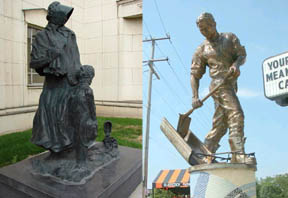
Two more examples of generic concensus figurative artworks
Ever Pressing Forward, Karl A. Quilter, 2001
The International Society Daughters of Utah Pioneers pay tribute to those who made the trek in the valley of the Great Salt Lake and those who died along the way, 1847-1869. The statue is of a pioneer mother and her son.
Building the Lincoln Highway, Katheen Farrell, 2004
An early 20th century project by Carl Fischer to link NYC and San Francisco by road. (Fischer also invented the Dixie Highway linking Miami and Detroit)
Both images from the marvelous WayMarking website.
Digg it...Del.icio.us ...Technorati...Stumble Upon..Reddit
hiding inside the black granite.
I said I wouldn't,
dammit: No tears.
I'm stone. I'm flesh.
First 5 Lines "Facing It", Yusef Komunyakaa, 2001
Komunyakaa wrote the poem at national Vietnam War Memorial. Its polished granite also reflects the white Washington Monument, a strange object of Masonic symbolism at the political heart of America. The Egyptian obelisk was reborn in the Americas and elsewhere due to its association with a powerful "boys" club. During the Mason's strength between 1750 and WWI, the obelisk became a shape for graves, memorials and monuments to events. Today - not much use.
Student newspaper writer, Diana Greenwald, brought to my attention a temporary obelisk by Damian Ortega. Obelisco Transportable, a 20 ft tall black polish sculpture, has been rolling on a tiny spot of grass this summer in New York City. According to the Public Art Fund website, Ortega created "a mobile landmark" that one could potentially move anywhere to commemorate anything. Unfortunately, Greenwald reports that New Yorkers did not even notice the artwork and it sparked no ideas when pointed out by the young reporter.
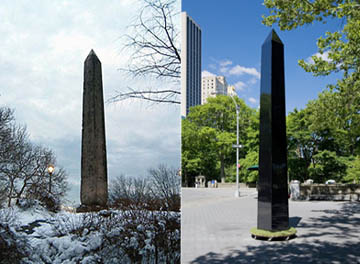
NYC's Cleopatra's Needle and Ortega
![]()
Beacon Hill Monument and Ortega
Ortega's gallery work is a series of paradies of minimalism and conceptual sculpture. When examining his work, you get the feeling - "Look how easy it is to make a conceptual work. I can do Lewitt out of chairs". The jokes require a knowledge not of only the past work, but the thinking and attitudes around both the creation of the art and the excessive 40 years of academic admiration. Ortega's basic starting point of dialogue with this obsurity generates its failure as public art.
Unfolding / Flip Chair, 2005 and Módulo de construcción con tortillas, 1998
Ortega selects the obelisk as its has the same obsurity as 1960s artwork. As giantic versions exist as national symbols in the USA, Argentina,etc., the smaller ones are ignored. In the public imagination, the purity of the blank geometic shape only succeeds with size, for otherwise no meaning is attached to it. Scale is part of it. For example, I had no idea that the grave markers of Washington, Jefferson and Madison were small obelisks. And in my hundreds of walks in Central Park, I do not remember Cleopatra's Needle, one of the 21 existing large Egyptian obelisks in the world, according to PBS's Nova.
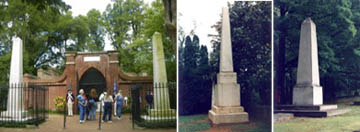
Masonic Graves: Washington, Madison and Jefferson
When the obelisk succeeds, they are placed at the center or the end. For example, see the plan of baroque Rome with its re-sited obelisks stolen by ancient Romans 1500 years before Pope Sixtus. Or the Washington Memorial at the intersection of the White House(President) and the Capitol (Representive Democracy). Or the Vicksburg, Mississippi, Civil War memorials (one of America's great overlooked sculpture landscapes) at the locations of death. Ortega lets the sculpture float without its primary role of marking a spot. Obelisks are not about themselves. Ortega just laughs at the valuelessness of contemporary spots, rather than challenging us by selecting a spot.
To demonstrate Ortega's fear of marking a place, I used the old trick of sending the "thing" on a world tour via photoshop.
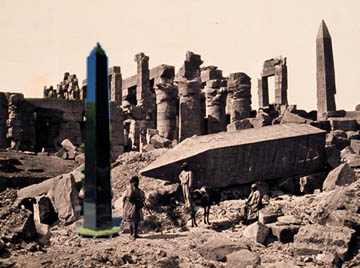
1863 in Karnac, Egypt and Ortega (Photo by Frith)
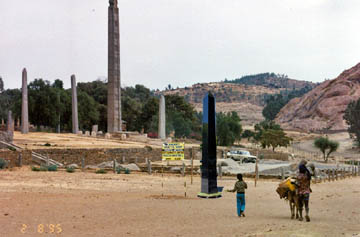
Axum, Ethiopia and Ortega
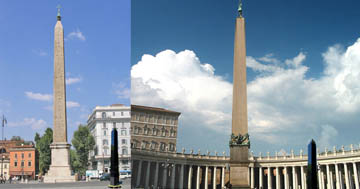
The Emperor, the Pope and Ortega
Ortega at Vicksburg, Mississippi
To demonstrate the sculpture's lack of strength as a work of public art, I remind you of the infamous slab that appeared in a Seattle park on January 1, 2001. The unknown artist placed the slab without disturbing the earth so it had the appearance of dropping out the sky. The surprise arrival was brilliantly upstaged by the artist when he or she removed the slab one day later. The work's had perfect symetry with Stanley Kubrick's movie and drove the public's imagination to that place of mystery at the start of the universe
Kubrick and Seattle One Day Monument, Jan 1, 2001
Digg it...Del.icio.us ...Technorati...Stumble Upon..Reddit
Conflux takes me back. Those days in your 20s when engaging people on the street was so powerful. You need a break from the white walls. Time to put art out there with a lot of other artists out there. For a month ahead of time, you talk with your friends and quasi-friends about your plans. On the day, you set up and go. Something a little strange happens with the non-art people. They say something to you or to each other. It doesn't matter what, but the artists that gets the most people or the most enthusiastic reaction wins in the story telling back at the gallery. (Never tell your parents except to prove how different you are from them.) The stories can be told for at least six months. Some for a lifetime.
But the best part is that every artist is sure that this is the first time "something like this" has been done on the street. It is invented to be different. Paintings and sculpture can have some common traits, but these volunteer actions are absolutely unique. Of course its not 100%, but it feels that way. And why not enjoyed it for a weekend.
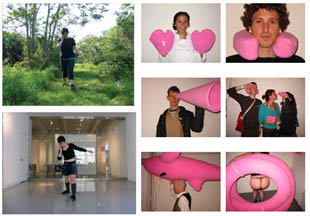
Rebecca Nagle....................Kurt Bigenho
Conflux is on going in Brooklyn, New York, this weekend September 13-16, 2007. For the stories, 8PM to close at the Luna Lounge, 361 Metropolitan Avenue, Brooklyn. I wish I could blend in and here the tales.
Check out the website for complete descriptions. As see it, these artists share the following purposes with my past: to personalize the city in the way the lonely artist knows the city; to perform anonymously while hoping to be recognized; and to spark some energy or thought into the non-art public for a moment.
Here are a few of the 100 events. You need to read the statements to fully remember those early days.
1. Tour based on Ghostbusters
2. Tours of real and invented Acid Rain
3. Suggestions of personal stories through posted polaroids with a message
4. Soda cans that make noises until you get too close like a cricket
5. Tell the artist through the cellphone your movements and she will repeat the motions wherever she is.
6. Wear strange pink things in public
7. Stand in the median with a message written on cardboard
8. Giant expandable duct as a traffic blocker and tunnel to safely cross the street
9. People embracing in a powerful HUG on busy sidewalks
And just to prove my credentials to any 20 somethings reading this blog, I lived on Java Street in Greenpoint in the early 1980s before I moved to Williamsburg and then Seattle.
All my love.
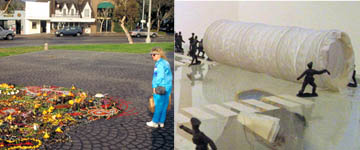
Joe Mangrum.......................Eh-Team
Michael Dory............................Caroline Woolard
ALL READY AN UPDATE: MATCHING PAST AND PRESENT
Forty years ago in 1967, experimental artist and cellist Charlotte Moorman organized the fifth annual New York Avant-Garde Festival -- 24 hours of non-stop performance aboard the John F. Kennedy ferry by 100 artists.
On Saturday, Tianna Kennedy, an experimental artist and cellist from this generation, plans to dedicate the 24-minute piece she'll play aboard the Guy V. Molinari to the little-known artists in Moorman's festival. Part of the www.fmferryexperiment.net.
Digg it....... Del.icio.us ....... Technorati.....Stumble Upon
British artist, Julian Beever, must be the most popular public art on the Internet. At least once every two months, a family member, friend or associate sends me a set of his street chalk drawings. I politely reply "Thank you."
Julian Beever, Sidewalk Chalk Drawing on High Street, London, UK Date Unknown
Beever's fans always describe the illusions as "amazing!" with the exclamation mark. Not a single fan has seen the drawings in person. The amazement is the technical illusion of holes in the ground and things in the air. To achieve the illusion, Beever must elongate the image across great distances of the pavement. Only in this way can the out stretched leg cut across the background of the visual field as though it was in the air, instead of drawn on the ground. Not every type image will work. Beever does know what he is doing.
Beever's perspective is the revival of perspective caused by the camera. In fact, you can see the camera in the second image that he must use to do the drawing and take the pictures filling up my mailbox.
Beever on High Street with Camera and Bruneleschi's Prespective System.
Perspective, as developed by Filippo Brunelleschi around 1410 in Italy, is a mathematicians trick and really quite strange. It depends 100% on the tiny, finite viewing point and the tiny, infinite vanishing point (or points). The world in front of the person is drawn on a flat surface as though the eye of the person never moved during the creation. That is why Brunelleschi used a tiny hole to make his view. This process was imagined without a camera and photograph that has the same effect. He must have had to convince himself and others that it looked like reality. Or like the Ottomans never achieved, convince themselves that the role of painting was to replicate reality instead of the vision of god.
The strange part of perspective is how little it is used in its pure mathematical form. In the Della Francesca 1474 painting, the mathematics creates a forced and stiff vision that does not relate to the human memory build up as a moving body instead of the static eye of perspective. The stuff that is called perspective is actual very loose and manipulated by the artist to make the painting more realistic. Fuzzy math.
Della Francesca, 1474 and Felice Varini, 2003
Today, two artists are exploring perspective in reverse. Felice Varini and Georges Rousse paint the world to prepare it for a vision in perspective. I assume that both artists develop the project by overlaying simple geometric shapes or lines on a photograph. All the work on the web appears to be rather uninspiring photoshopped images by any amateur, but the relationship to the history of perspective and the camera interests me.
Felice Varini, 1986 and Georges Rousse, 2006
The artists paint color over the walls, ceilings, floors, windows, railings, desks... such the viewer or camera in one perfect place can witness the colored surfaces merging into a perfect geometric shape or shapes. As the head or camera moves a tiny bit, the perfection is lost.
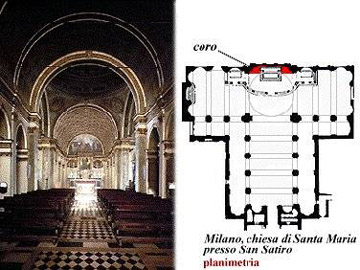
Donato Bramante, Santa Maria presso San Satiro, Milan, IT 1486
In these works, the perspective is drawn by the artist and the viewer must find the place in space to make the mathematics work. In the open spaces of Varini and Rousse, the body moves in response to the mental imagine of perfect geometry. This is different from Bramante's use of the perspective painting to complete the choir behind the alter at Santa Maria presso San Satiro, 1486, and the Palladio/Scamozzi collaboration of vanishing streets in the Teatro Olympio, 1585. In both these audience fills the church or theater in perfect linear relationship to the illusion. The body does not adjust to the perspective. Borromini's alcove, 1632, at Palazzo Spada requires some bodily adjustment to setup the illusion that the sculpture is full human scale.
Vincenzo Scamozzi, Teatro Olimpico Stage Set, Vicenza, IT 1585
Building designed by Andrea Palladio
Carlos Borromini, Palazzo Spada Alcove, Rome, II 1632
Optical illusion of a gallery 37 meters long (it is 8 meters) with a lifesize sculpture in daylight beyond: the sculpture is 60 cm high.
Who cares about this fun house game? Is it any different from the crazy room where the water appears to run uphill or the house of mirrors where the viewer moves to see different arrangements of the infinitely repeating self?
Answer in the next essay for Varini and Rousse are quite different on this point because Varini creates for the installation FOR the space and Rousse FOR the photograph. In the next entry, I will deal with these two contemporary artists doing exactly the same thing. In the American world, Varini should be suing Rousse on grounds of intellectual copyright infringement. But this is a perfect test case for the future of vernacular art.
Felice Varini, Cardiff Bay Barrage, Wales. UK 2007
Georges Rousse, Installations in Durham, North Carolina, US, 2006
SPECIAL THANKS to A. Dabusti and M.Lagomarsini for the drawings on perspective at from the Istituto Maserati.
Digg it....... Save to Del.icio.us ....... Save to Technorati
Around 1985, two architects in Chicago got access to one of the first giant photocopy machines. The photocopier could make images 36 inches wide and very long. Several architects drew 1 inch by 3 inch drawings that were then enlarged to 3 ft x 9 ft through multiple photocopying. The ensuing exhibition was titled: "The Idea of Big". 22 years later - so crude, so small.
Emperors, architects and filmmakers have always been drawn to the big - or rather - the enlarged. The objects change scale and fill the eye. Imaginatively and somewhat phenomenology, people assume the role of an ant in the presence of the giant thing. Yet humans made the giant, so share in the feeling of power. Were we not BOTH Godzilla and the Japanese as he smashed Tokyo? King and plebe.
In Denver, the Bigs have gathered in downtown. Works by Lawrence Argent (bear), Coosje van Bruggen & Claus Oldenburg (broom and dust pan), Dan Ostermiller (cow and calf), Donald Lipski (horse on a chair) and Louise Bourgeois (spider). Bruggen/Oldenburg are ahead of Argent on Flickr because of location relative to camera happy cultural tourists and that "Big Sweep" is climbable. (I remark on Flickr as I am curious to discover what makes certain artworks attract photographers).
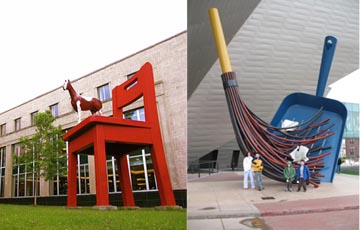
Lipsky and Bruggen/Oldenburg in Denver
Bourgeois and Ostermiller in Denver
Of the works, only Argent's "I See What You Mean" is public art. I consider the essence of public art as the ability to spark a relationship with its site - surroundings, the social culture and moment. This is different from originating from a site such as retelling or referring to its history although retelling could be part of the spark.
For the simple test of public art, just imagine its removal and erase its history in the place. Now replace the artwork with another artwork of the same size. If everything is the same, then the work is "art in a public place." In good situations, the surroundings gently hold the work like a gallery. In the best situations, the work enlivens the space. Like the most excellent architecture, achieving this physical interaction between art and space is no easy task and worth the effort to achieve.
Public art must interact with its space, but that space must appear as its home, its office or its jail. A psychological state is demanded. Argent's Big Blue Bear comes to work everyday at the Denver Convention Center. Most of Jonathan Borofsky's sculptures work, too. Hammering Man works literally and Ballerina Clown must come to Venice Beach each day to dance like Argent's bear must look. (In the 1990's, a giant ball and chain was attached to Seattle's Hammering Man. The second artist felt the psychological jail.)
Borofsky's Hammering Man, Seattle, WA, 1990? and Ballerina Clown, Venice, CA, 1989
The Ballerina and the Bear share another quality: homelessness. The Ballerina's spirit arises from the homeless men of Venice Beach. Men who invent a world inside their heads and then live it for moments without a concern for the audience on the sidewalk. The Bear has lost his way into Denver like so many animals forced into cities with the destruction of the natural homes. Also just like the homeless. The bear, out of place, stops and looks. Like the Ballerina and the permanently homeless, the bear's look is so intense that he forgets where he is. For a moment, he is not physically lost, but mentally displaced into his action of looking.
Of course this looking is in the classic pose of tourist photographs, paintings and cartoons of the bear on his hind legs staring into the window of the car or the cabin. An image born in the car camping mountains of the western USA. The bear is curious about the potential food. He is not just looking, but hunting.
The activities of the Convention Center are a mystery to the average resident. Ten of thousands of civic strangers come and go. They are on a kind of corporate vacation, spending the boss' money and being paid at the same time. Other corporate employees are selling the best of new products and services. Everything is new. Just off the designers' table. But nothing can be seen without the hanging ID card on the chest.
The bear looks for all the Denver citizens who can't go in. The bear is trying to see the new sparkly stuff and the handsome wandering people who stop for laugh now and then. The bear repeats the action any outsider and sticks his nose on the glass and blocks the glare with his hands. The closer to the glass, the more can be seen inside. Closer to the glass, the more obvious the outside status to the ones inside.
"I See What You Mean", 2005, The Bear and Bear
For the convention attendee, the bear is a silhouette and a good laugh first time. But if the attendee is bored on the balcony at the bear's stomach, she or he might think of Godzilla, King Kong and other fantasies of the giant animal. Like those fictions, the beast could smash the glass and enter the building, but instead he politely respects the social agreement that the glass is impenetrable The attendee knows that he or she is an insider this week, but most weeks, she or he is outside looking in. In this American world, we trade positions by the week, day and hour.
Of course, the most obvious, is that fact that the bear is looking into a place full of surveillance cameras. The kindly bear looks and the camera protect the attendees. The looking is passive at the moment, but that could change.
To achieve recognition as an iconic public work, the work must transform known images and experiences. Even if the Colorado resident or visitor has not been with a bear in the woods, enough media images exist to fill the mind. The visitor hopes and fears to meet the bear. The experienced camper wishes to co-exist without really bothering each other.
The Other Colorado Bears: Yogi and Smokey
The bear is part of the lost west. As an American child, Yogi Bear and Smokey Bear gave me the impression that the bears lived in the mountains. As a man, I know the bear's are disappearing into mythology. Only by the efforts of the park rangers and scientists do we have any bears in the woods. Man, not nature, secures the bear.
Paul Bunyan and Babe the Blue Ox in Kamath, California
As bear turns to myth, the bear becomes blue. The other American mythical figure of the woods is Paul Bunyan and Babe the Blue Ox. In this myth, Bunyan with his axe and ox, subdued the forests. The extremely cold winter of blue snow into which Babe was born, turned the ox blue. Perhaps like Babe, the bear has the miracle of survival.
Surroundings, the social culture and moment..... The Big Blue Bear links to its place at the Convention Center with its action of looking in. It ties to the images of the West generated in pop culture, documentary photography and real (or imagined) nights in the woods. The bear preserves the moment in time when looking is still real and done in the flesh.
Unlike the Ostermiller's cows and Bruggen/Oldenburg broom, my mind has many places to wander. The cows are just bigger cows relaxing out-of-place in the city. The broom sweeps the dust from the angled corners of the museum. Both can be moved to any time to any place and succeed. Not the bear, and that is its wonder.
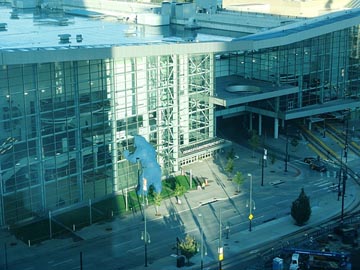
Argent's Bear at the Site
Digg it....... Save to Del.icio.us ....... Save to Technorati
Are you missing the crucial lectures on contemporary public art, urban design and architecture? Well I am. Please help me put together an online list to lectures in video or other formats that include visuals and serious thoughts together. Below are a very few that I have found. Must be a lot more.
UPDATE:
On September 5, 2007, slate.com launched slateV.com with 2-4 minute video essays by thier writers. Two years ago, art and architecture critics amoung other slate.com writers started using a very simple slideshow format for the reviews.
UPDATE 2: I-Tunes U was launched this summer as a free service to download audio or video presentations. About 20 universities participating. Only a few Planning, Art and Architecture lectures so far. MIT has better video quality on I-Tunes than at Open Courseware. You must download the I-Tunes Software and use the download for FREE through the Store. One confusion. For videos, the download button must read "Get Movie". If not, then the download is an audio file.
Tate Modern Event Archive, London
Antony Gormley
Rachel Whitehead
Tracy Emin
Dan Graham
Public Art Discusion with Kathrin Böhm, Lucy Orta and Richard Woods
Christo
Tschumi and Colomina
Arthur Danto and others
Ilya Kabakov
Jacques Herzog
The Walker Channel, Minneapolis
Kiki Smith and Peter Schjeldahl
Antenna Design: Masamichi Udagawa and Sigi Moeslinger
WGBH Forum Network, Boston
Suzi Gablick: Paradigm Spinning: Artists as Agents of Social Change
I-Tunes U
Wendy Ewald on Margate Project in England, MIT Page
EVENT NOTICES
New York City, Sept 8 at 4 PM
Creative Time Art Parade
Deitch Projects, Creative Time and Paper Magazine are pleased to announce the third annual Art Parade. The parade will take place on Saturday September 8, at 4PM, on West Broadway. The route will begin on Houston and follow West Broadway, ending on Grand Street.
Photos from 2006 Art Parade
London, September 21, 2007
Building Culture: Can Artists Make Great Places
Strangely, ONLY ONE ARTIST IS SPEAKING: Richard Wentworth
Creativity, Culture and Change are the themes of a one-day conference on leading regeneration projects through art and creativity with a focus on the mega-development at Kings Cross. The event will include presentations of Artists for Places - a partnership between CABE, A&B and Arts Council England; an evaluation by Comedia on the PROJECT scheme to support public art strategies embedded within the planning system; an open forum with key speakers on art, architecture, landscape and planning, debating the role or art and cultural activity within the design of the built environment. Part of Urban Design Week, London
Richard Wentworth
See his thinking process for a new urban space in Walsall, UK. Click on the Love Letter
Sponsored in Part by IXIA, a think tank for public art practice.
Ixia is working on a public art manifesto and has posted a set of other manifestos.
Digg it....... Save to Del.icio.us ....... Save to Technorati
Blogroll
AJ Ads
AJ Blogs
AJBlogCentral | rssculture
Terry Teachout on the arts in New York City
Andrew Taylor on the business of arts & culture
rock culture approximately
Laura Collins-Hughes on arts, culture and coverage
Richard Kessler on arts education
Douglas McLennan's blog
Dalouge Smith advocates for the Arts
Art from the American Outback
For immediate release: the arts are marketable
No genre is the new genre
David Jays on theatre and dance
Paul Levy measures the Angles
Judith H. Dobrzynski on Culture
John Rockwell on the arts
Jan Herman - arts, media & culture with 'tude
dance
Apollinaire Scherr talks about dance
Tobi Tobias on dance et al...
jazz
Howard Mandel's freelance Urban Improvisation
Focus on New Orleans. Jazz and Other Sounds
Doug Ramsey on Jazz and other matters...
media
Jeff Weinstein's Cultural Mixology
Martha Bayles on Film...
classical music
Fresh ideas on building arts communities
Greg Sandow performs a book-in-progress
Exploring Orchestras w/ Henry Fogel
Harvey Sachs on music, and various digressions
Bruce Brubaker on all things Piano
Kyle Gann on music after the fact
Greg Sandow on the future of Classical Music
Norman Lebrecht on Shifting Sound Worlds
publishing
Jerome Weeks on Books
Scott McLemee on books, ideas & trash-culture ephemera
theatre
Wendy Rosenfield: covering drama, onstage and off
Chloe Veltman on how culture will save the world
visual
Public Art, Public Space
Regina Hackett takes her Art To Go
John Perreault's art diary
Lee Rosenbaum's Cultural Commentary
Tyler Green's modern & contemporary art blog
